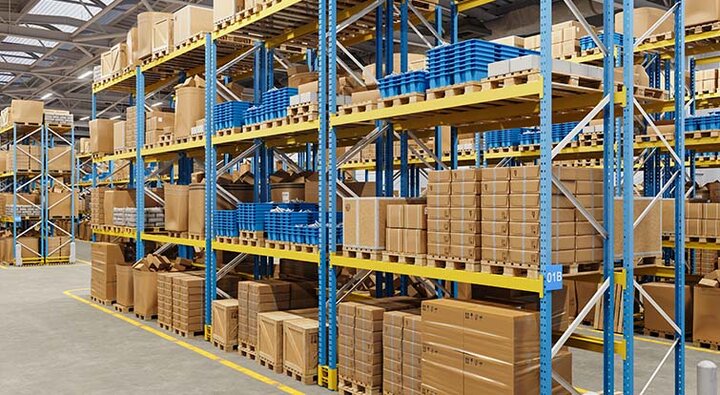Starting with item-level visibility and centralized purchase orders, retailers who manage inventory with precision will be the winners.
— Noah Hoffman, VP for retail logistics at C.H. Robinson




With consumers starting their holiday shopping earlier this year and scaling back their gift-giving budgets, having the right items in stock with the right assortment is critical. Retailers and retail suppliers who forecast, manage and move inventory efficiently will avoid missed sales while also offsetting the pressures of higher tariffs.
Many of C.H. Robinson’s 7,500 retail customers imported at least some holiday inventory ahead of higher U.S. tariffs slated for August. Whereas peak season for ocean shipping normally runs through October, this year it peaked in July and the Port of Los Angeles set an all-time record. But not everyone’s manufacturers or suppliers could ramp up in time, and you may have intentionally waited on some of your inventory either because ocean shipping rates had jumped or you hoped that trade deals or court challenges would knock tariffs down.
Like those who attended our recent retail summit, your pre-tariff inventory is probably dwindling or depleted now and you’ve already implemented all possible internal efficiencies to offset your unexpected tariff costs. Consumer shopping patterns in October – including the big pre-Black Friday sales – served as a starting point for what’s hot or not this holiday season, how you should approach your replenishment strategy and how you can more precisely get your merchandise where it’s needed.
Here are three key considerations for your supply chain at the start of this holiday season.
Know and manage your true import costs before replenishing
Tariffs have injected new and constantly changing complexities into retail supply chains. Though the U.S. Supreme Court is considering the legality of how some tariffs were imposed, a decision isn’t expected till November or December and it’s uncertain if or when companies may be reimbursed. Meanwhile, new tariffs unaffected by the court challenge keep getting added and the list of items subject to existing tariffs continues to expand.
While retailers may be struggling to stay abreast of their tariff exposure in this environment, a number of tools can help. For example, C.H. Robinson launched a U.S. Tariff Impact Analysis Tool that’s like having a spotlight in a dark room. One of our customers discovered that 70% of their duty expenses were tied to a single tariff. With that insight, they could look at their purchases country-by-country and product-by-product to reduce that cost.
While considering your options, keep in mind that your true import costs are dictated not just by your sourcing decisions and their tariff implications, but also by fluctuations in shipping rates, your port selection, your freight consolidation choices, and how you move your merchandise inland once it arrives.
For imports from Asia to North America, ocean shipping rates are trending downward and opening up savings opportunities. However, that comes with a risk of unreliable schedules. With weaker demand, ocean carriers are canceling vessel departures, which reduces departure port options and service frequency, while remaining vessels may sail with different schedules or skip destination ports. Retailers may want to secure guaranteed space for time-sensitive cargo, while moving up some non-urgent shipments to capture today's favorable ocean spot rates. Air rates from Asia have remained firm as demand is expected to remain strong through December and into January.
For European imports, ocean rates are stable and capacity is ample. Air rates will likely stay above historical averages for the rest of peak season. Retailers flying in goods from Europe are encouraged to secure space early.
Logistics providers that handle ocean, air, rail and truck shipping while also doing customs brokerage have the expertise and tools to help you make more informed decisions.
Optimize your inventory down to the item level
Especially when consumers are buying with restraint and spreading out their holiday purchasing, you may need to adjust your logistics for smaller orders. While that can seem like you’ll lose some of the economies of scale you typically rely on, there are other ways to find efficiencies and cost savings. Starting with item-level visibility and centralized purchase orders, retailers who manage inventory with precision will be the winners.
Many retailers have little visibility into their inbound supply chains because they purchase goods from their suppliers with the storage and transportation costs included. That means their supplier is the one who knows what items are where and in what quantity. The retailer knows that air fryers are flying off their store shelves in Georgia, but might not know they don’t have to order more because there’s a warehouse full of them in New Jersey, where the item hasn’t been selling as briskly.
With item-level visibility, we can pinpoint where the air fryers are, truck them where they need to be, lower the retailer’s carrying costs in New Jersey and capture more sales in Georgia. Then with centralized purchase orders, a new order is triggered only when and where it’s needed and only in the quantity needed.
This more granular approach enables much better alignment between your inventory, demand and transportation.
Optimize your trucking, too
Using our proprietary AI artificial intelligence, we just conducted an analysis for a retailer who’s experiencing less demand for an assortment of products they used to need by the truckload. They’re running less-than-truckload routes with six, seven or eight smaller pickups at their various suppliers, which creates a lot of wasted miles and dwell time to fill each truck.
By more efficiently bringing all their products directly to one of our nearby retail consolidation centers instead, we can combine smaller quantities of each product to create full truckload density to all their distribution centers across the country. They can achieve a 40% increase in trailer utilization and remove over 7,700 deliveries annually.
Smaller vehicles are another great option for retailers finding themselves ordering in smaller quantities. Straight trucks or box trucks can be cost-effective and also improve speed.




As the President and COO of Mercatus, Sylvain Perrier leads the development and execution of the company’s strategic initiatives, focusing on integrating cutting-edge commerce technology with enterprise SaaS solutions to revolutionize the retail shopping experience.
Perrier manages a diverse team across various departments, fostering external partnerships and leveraging deep market insights to drive growth and technological innovation at Mercatus.
Prior to joining Mercatus, Perrier held several leadership positions with leading tech firms including BrightLane Inc., Springboard Retail Networks, and In-Touch Survey Systems.